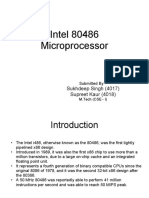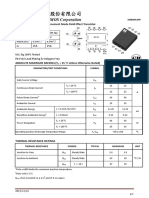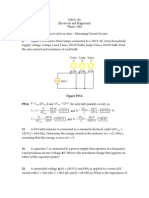80386
80386
Uploaded by
Peejay OllabracCopyright:
Available Formats
80386
80386
Uploaded by
Peejay OllabracOriginal Description:
Copyright
Available Formats
Share this document
Did you find this document useful?
Is this content inappropriate?
Copyright:
Available Formats
80386
80386
Uploaded by
Peejay OllabracCopyright:
Available Formats
80386
OVERVIEW:
Intel 386
Intel 80386 DX rated at 16 MHz
Produced From 1985 to September 2007
Common
manufacturer(s)
Intel
AMD
IBM
Max. CPU clock rate 12 MHz to 40 MHz
Min. feature size 1.5m to 1m
Instruction set x86 (IA-32)
Predecessor Intel 80286
Successor Intel 80486
Transistors 275,000
Price $299
Pins 132
Package(s)
132-pin PGA, 132-pin
PQFP; SX variant: 88-
pin PGA, 100-pin
PQFP
HISTORY:
The 80386 ("eighty-three-eighty-six"), family of
microprocessors of Intel Corporation is the first 32 bit
version of the 8086 family-a switch from 16 bit to 32 bit
having 5 MIPS.
Chief architect in the development of the 80386 was John
H. Crawford
80386 has upward compatibility with 8086,8088,80286 etc
The 80386 was launched in October 1985, but full-function
chips were first delivered in the third quarter of 1986
Although it had long been obsolete as a personal
computer CPU, Intel and others had continued making the
chip for embedded systems.
A 33 MHz 80386 was reportedly measured to operate at
about 11.4 MIPS.
The first personal computer to make use of the 80386 was
designed and manufactured by Compaq.
May 2006, Intel announced that 80386 production would
stop at the end of September 2007
In 1988, Intel introduced the i386SX.
Used in aerospace technology, some mobile phones also
used the 80386 processor, such as BlackBerry 950
[8]
and
Nokia 9000 Communicator.
AMD introduced its compatible Am386 processor in March
1991.
The AMD Am386SX and Am386DX were almost exact
clones of the 80386SX and 80386DX having 40MHz.
Chips and Technologies Super386 38600SX and 38600DX
were developed using reverse engineering. They sold
poorly, due to some technical errors and incompatibilities,
Cyrix Cx486SLC/Cx486DLC could be (simplistically)
described as a kind of 386/486 hybrid chip that included a
small amount of on-chip cache.
IBM 386SLC and 486SLC/DLC were variants of Intel's
design which contained a large amount of on-chip cache (8
kB, and later 16 kB).
VERSIONS OF 80386:
80386DX the full version
The first member in 80386 family
this CPU could work with 16-bit and 32-bit external buses.
Comprises of both 32-bit internal registers and 32-bit
external bus.
80386SX the reduced bus version
low cost version of the 80386.
This processor had 16 bit external data bus,32-bit internal
registers and 24-bit external address bus.
80386SL
low-power microprocessor with power management
features, with 16-bit external data bus and 24-bit external
address bus.
The processor included ISA bus controller, memory
controller and cache controller.
Embedded 80376 and 80386EX processors.- Still in use today.
ARCHITECTURE:
To enhance performance 80386 has 6 functional units,
processing in parallel:
The bus unit:
is the interface to the external devices.
The prefetch unit:
unit performs a mechanism known as
an instruction stream queue.
The decode unit:
accesses the output end of the prefetch
units instruction queue.
The execution unit:
involves the arithmetic/logic unit-ALU,
registers, special multiply, divide, and
shift hardware, and a control ROM.
The page unit &
The segment unit:
provide the memory management and
protection services for the 80386.
OPERATING MODES:
*real mode, protected mode and virtual mode.
80486
Intel 486
The exposed die of an Intel 80486DX2 microprocessor
Produced From 1989 to 2007
Common
manufacturer(s)
Intel, IBM, AMD, Texas
Instruments, Harris
Semiconductor, UMC, SGS
Thomson
Max. CPU clock rate 16 MHz to 100 MHz
FSB speeds 16 MHz to 50 MHz
Min. feature size 1m to 0.6m
Instruction set x86 including x87 (except for "SX" models)
Predecessor Intel 80386
Successor Pentium (P5)
Package(s)
PGA (socket 1, 2, 3), 196-pin PQFP,
208-pin SQFP
Only few differences between the 80486 and 80386, but
these differences created a significant performance
improvement.
32 bit microprocessor and same register set as 80386.
Few additional instructions were added to its instruction
set.
4 gigabyte addressing space .
HISTORY:
The first tightly pipelined x86 design as well as the first x86
chip to use more than a million transistors.
A 50 MHz executed around 40 MIPS on average and was
able to reach 50 MIPS peak performance.
80486 was announced at Spring Comdex in April 1989,
Intel stated that samples would be available in the third
quarter of 1989 and production quantities would ship in
the fourth quarter of 1989.
IMPROVEMENTS MADE IN 80486 OVER 80386:
80486 was powered with a 8KB cache memory.
This improved the speed of 80486 processor to great
extent.
Some new 80486 instructions are included to maintain the
cache.
It uses four way set associative cache.
80486 also uses a co-processor similar to 80387 used with
80386.
But this co-processor is integrated on the chip allows it to
execute instructions 3 times faster as 386/387
combination.
The new design of 80486 allows the instruction to execute
with fewer clock cycles.
486 is packed with 168 pin grid array package instead of
the 132 pin used for 386 processor.
This additional pins made room for the additional signals.
This new design of 80486 allows the instruction to execute
with fewer clock cycles.
These small differences made 80486 more powerful
processor.
VERSIONS:
AMD produced several clones of the 486 using a 40 MHz
bus (486DX-40, 486DX/2-80, and 486DX/4-120) which had
no equivalent available from Intel, as well as a part
specified for 90 MHz, using a 30 MHz external clock, that
was sold only to OEMs.
The fastest running 486 CPU, the Am5x86, ran at 133 MHz
and was released by AMD in 1995. 150 MHz and 160 MHz
parts were planned but never officially released.
Cyrix's early offerings included the 486DLC and 486SLC.,
two hybrid chips which plugged into 386DX or SX sockets
respectively, and offered 1 KB of cache (versus 8 KB for the
then-current Intel/AMD parts).
The Motorola 68040 (best known for its use in the
Macintosh Quadra series), while not compatible with the
486, was often positioned as the 486's equivalent in
features and performance.
One of the earliest complete systems to use the 80486
chip was the Apricot VX FT, produced by United Kingdom
hardware manufacturer Apricot Computers.
Model
Specified max
clock
Voltage
L1-
Cache
Introduced Notes
i486DX (P4)
20, 25 MHz
33 MHz
50 MHz
5V
8 KB
WT
April 1989
May 1990
June 1991
The original chip (without any clock doubling)
i486SL 20, 25, 33 MHz
5V or
3.3V
8 KB
WT
November
1992
Low power version of the i486DX, reduced VCore,
SMM (System Management Mode), stop clock, and
power saving features mainly for use in portable
computers
i486SX (P23)
16, 20, 25 MHz
33 MHz
5V
8 KB
WT
September
1991
September
1992
An i486DX with the FPU part disabled or missing.
Early variants were parts with disabled (defective)
FPUs.
[5]
Later versions had the FPU removed from the
die to reduce area and hence cost.
i486DX2
(P24)
40/20,
50/25 MHz
66/33 MHz
5V
8 KB
WT
March 1992
August 1992
The internal processor clock runs at twice the clock
rate of the external bus clock
i486DX-S
(P4S)
33 MHz;
50 MHz
5V or
3.3V
8 KB
WT
June 1993 SL Enhanced 486DX
i486DX2-S
(P24S)
40/20,
50/25 MHz
(66/33 MHz)
5V or
3.3V
8 KB
WT
June 1993
i486SX-S
(P23S)
25, 33 MHz
5V or
3.3V
8 KB
WT
June 1993 SL Enhanced 486SX
i486SX2
50/25,
66/33 MHz
5V
8 KB
WT
March 1994 i486DX2 with the FPU disabled
IntelDX4
(P24C)
75/25,
100/33 MHz
3.3V
16 KB
WT
March 1994
Designed to run at triple clock rate (not quadruple as
often believed; the DX3, which was meant to run at
2.5x the clock speed, was never released). DX4
models that featured write-back cache were
identified by an "&EW" laser etched into their top
surface, while the write-through models were
identified by "&E".
IntelDX4WB 100/33 MHz 3.3V
16 KB
WB
October 1994
i486DX2WB
(P24D)
50/25,
66/33 MHz
5V
8 KB
WB
October 1994
i486DX2
(P24LM)
90/30 MHz;
100/33 MHz
2.5
2.9V
8 KB
WT
1994
i486GX up to 33 MHz 3.3V
8 KB
WT
Embedded Ultra-Low power CPU with all features of
the i486SX and 16 Bit external data bus. This CPU is
for embedded battery-operated and hand-held
applications.
PENTIUM
OVERVIEW:
Pentium
2009present logo
Produced From March 22, 1993 to present
Common manufacturer(s)
Intel
Max. CPU clock rate 60 MHz to 3.8 GHz
FSB speeds 60 MHz to 1333 MT/s
Min. feature size 0.8 m to 22 nm
Instruction set x86, x86-64
Microarchitecture P5
Cores 12
Predecessor Intel 80486
Socket(s)
Socket 4.5.7
L1 Cache 16-32KiB
HISTORY:
Intel wanted to prevent their competitors from
branding their processors with similar names, as AMD
had done with their Am486.
The name Pentium is originally derived from
the Greek word pente meaning 'five' as the series was
Intel's 5th generation microarchitecture suffix -ium
was chosen as it could connote a fundamental
ingredient of a computer, like a chemical element.
Intel rates as "two stars" meaning that it is above the
low-end Atom and Celeron products but below the
faster Core i3, i5 and i7 lines as well as the high-end
Xeon processors.
are typically used with a lower clock frequency, a
partially disabled L3 cache and some of the advanced
features such as hyper-threading and virtualization
disabled.
Marketing firm Lexicon Branding was hired to coin a
name for the new processor.
P5 Pentium competitors included the Motorola 68060
and the PowerPC 601 as well as the SPARC, MIPS, and
Alpha microprocessor families, most of which also
used a superscalar in-order dual instruction pipeline
configuration at some time
Designed by the same Santa Clara team which
designed the 386 and 486. Design work started in
1989; the team decided to use a superscalar
architecture, with on-chip cache, floating-point, and
branch prediction.
John H. Crawford, chief architect of the original 386,
co-managed the design of the P5, along with Donald
Alpert, who managed the architectural team. Dror
Avnon managed the design of the FPU. Vinod K.
Dham was general manager of the P5 group.
List of Intel Pentium Microprocessors:
Core Process Frequency L1
Cache
FSB Socket Release
date
P5 0.8 m 6066 MHz 16 KB 60
66 MHz
Socket
4
March
1993
P54C 0.6 m 75
120 MHz
16 KB 50
66 MHz
Socket
5
October
1994
P54CS 0.35 m 133
200 MHz
16 KB 60
66 MHz
Socket
7
June
1995
P55C 0.35 m 120
233 MHz
32 KB 60
66 MHz
Socket
7
January
1997
[12]
Tillamook 0.25 m 166
300 MHz
32 KB 66 MHz Socket
7
August
1997
Major improvements over i486 microarchitecture[edit]
Performance:
o Superscalar architecture The Pentium has two
datapaths (pipelines) that allow it to complete
two instructions per clock cycle in many cases.
The main pipe (U) can handle any instruction,
while the other (V) can handle the most common
simple instructions.
o 64-bit external databus doubles the amount of
information possible to read or write on each
memory access and therefore allows the
Pentium to load its code cache faster than the
80486; it also allows faster access and storage of
64-bit and 80-bit x87 FPU data.
o Separation of code and data caches lessens the
fetch and operand read/write conflicts
compared to the 486.
o Much faster floating point unit.
o Four-input address-adders enables the Pentium
to further reduce the address calculation latency
compared to the 80486.
o The microcode can employ both pipelines to
enable auto-repeating instructions
o A faster, fully hardware-based multiplier makes
instructions such as MUL and IMUL several times
as fast (and more predictable) than in the 80486;
the execution time is reduced from 13~42 clock
cycles down to 10~11 for 32-bit operands.
o Virtualized interrupt to speed up virtual 8086
mode.
Other features:
o Enhanced debug features with the introduction
of the Processor-based debug port.
o Enhanced self test features like the L1 cache
parity check.
You might also like
- Esa TrevDocument12 pagesEsa TrevPeejay Ollabrac100% (1)
- PlayStation Architecture: Architecture of Consoles: A Practical Analysis, #6From EverandPlayStation Architecture: Architecture of Consoles: A Practical Analysis, #6No ratings yet
- Semi Detailed Lesson Plan in ComputerDocument3 pagesSemi Detailed Lesson Plan in ComputerDennis Vigil Caballero56% (9)
- Computer Architecture and Organization: Intel 80386 ProcessorDocument15 pagesComputer Architecture and Organization: Intel 80386 ProcessorAtishay GoyalNo ratings yet
- Intel Microprocessor: Robert Jason D. Ramos 4-Bsece Computer System OrganizationDocument5 pagesIntel Microprocessor: Robert Jason D. Ramos 4-Bsece Computer System OrganizationRobert Jason RamosNo ratings yet
- Central Processing Unit: E5164 Diagnosis Senggaraan Sistem KomputerDocument38 pagesCentral Processing Unit: E5164 Diagnosis Senggaraan Sistem Komputerfred5181No ratings yet
- Intel 80486 Microprocessor: Sukhdeep Singh (4017) Supreet Kaur (4018)Document13 pagesIntel 80486 Microprocessor: Sukhdeep Singh (4017) Supreet Kaur (4018)Sonu AroraNo ratings yet
- Intel 80286: Produced Common Manufacturer(s) MaxDocument3 pagesIntel 80286: Produced Common Manufacturer(s) MaxaaaNo ratings yet
- Intel 80186 - WikipediaDocument18 pagesIntel 80186 - WikipediaAnasNo ratings yet
- X86 ArchitetureDocument17 pagesX86 Architetureseety2No ratings yet
- Intel 8086 Microprocessor FamilyDocument3 pagesIntel 8086 Microprocessor FamilyMusabbir Adnan TamimNo ratings yet
- MicroprocessorDocument12 pagesMicroprocessorMishalNo ratings yet
- Processor Families: by Prabhanshu Tripathi Ankit GuptaDocument25 pagesProcessor Families: by Prabhanshu Tripathi Ankit GuptaAnupam Kumar Sinha100% (1)
- Processor Families: by Prabhanshu Tripathi Ankit GuptaDocument25 pagesProcessor Families: by Prabhanshu Tripathi Ankit GuptaAnasNo ratings yet
- Chapter1 - The 80x86 MicroprocessorsDocument77 pagesChapter1 - The 80x86 MicroprocessorsAliaa TarekNo ratings yet
- The X86 Microprocessor: ObjectivesDocument32 pagesThe X86 Microprocessor: Objectivespapikhu36100% (4)
- ScribedDocument6 pagesScribedHemant MehtaNo ratings yet
- About 8086Document13 pagesAbout 8086Sunil KumarNo ratings yet
- 4thsem Microprocessor Notes PDFDocument148 pages4thsem Microprocessor Notes PDFVishal SharmaNo ratings yet
- Intel 8086Document4 pagesIntel 8086Shishir YalburgiNo ratings yet
- Intel 4004Document2 pagesIntel 4004Johnedel RosalesNo ratings yet
- The X86 Microprocessor & Alp: Microprocessors and MicrocontrollersDocument56 pagesThe X86 Microprocessor & Alp: Microprocessors and MicrocontrollersNaveen NNo ratings yet
- What Is Processor ?Document8 pagesWhat Is Processor ?Arya SinghNo ratings yet
- Insutraction To MicroprocessorsDocument18 pagesInsutraction To MicroprocessorshhfhNo ratings yet
- MP 08Document38 pagesMP 08AnasNo ratings yet
- Generations of Computer MicroprocessorsDocument68 pagesGenerations of Computer MicroprocessorsMKNo ratings yet
- Practical No. - 1Document55 pagesPractical No. - 1Rashi SharmaNo ratings yet
- Intel 8086 - Wikipedia, The Free EncyclopediaDocument9 pagesIntel 8086 - Wikipedia, The Free EncyclopediaGaurav KumarNo ratings yet
- x86 (Also Known As 80x86Document11 pagesx86 (Also Known As 80x86litianNo ratings yet
- Module 4 - CODocument10 pagesModule 4 - COAnnabelleNo ratings yet
- Chapter ThreeDocument4 pagesChapter Threeibrahin mahamedNo ratings yet
- 80386Document84 pages80386SridharNo ratings yet
- Unit IiiDocument8 pagesUnit IiiniranjjithbatheryNo ratings yet
- History Intel ProcessorsDocument5 pagesHistory Intel Processorsjohncel89100% (1)
- Ic 80186Document2 pagesIc 80186Joshua Quintos OnzaNo ratings yet
- Intel P5 (Microarchitecture) : Navigation SearchDocument13 pagesIntel P5 (Microarchitecture) : Navigation SearchLudwig McwillsNo ratings yet
- Intel IA32 (80x86) Microprocessors: Dr. Doug L. Hoffman Computer Science 330 Spring 2002Document28 pagesIntel IA32 (80x86) Microprocessors: Dr. Doug L. Hoffman Computer Science 330 Spring 2002amdevaNo ratings yet
- List of Intel MicroprocessorsDocument61 pagesList of Intel Microprocessorsfireball993No ratings yet
- Computer Hardware-03Document65 pagesComputer Hardware-03Diego AbadNo ratings yet
- AMD Project DevelopmentDocument21 pagesAMD Project DevelopmentKurarin Jan MaikeruNo ratings yet
- Intel Microprocessor Chapter 01Document86 pagesIntel Microprocessor Chapter 01Muhammad AwaisNo ratings yet
- Intel CpusDocument37 pagesIntel Cpus我叫政揚UwUNo ratings yet
- Chapter 2Document51 pagesChapter 2nguyenductinh2005101No ratings yet
- Whcamacho - It150-8 - Ass 2.1Document2 pagesWhcamacho - It150-8 - Ass 2.1MICKAELA YEOGE BASCONo ratings yet
- Intel MicroprocessorDocument35 pagesIntel MicroprocessorLissa JusohNo ratings yet
- 80286Document10 pages80286Jarah GutierrezNo ratings yet
- Omparison of Entium Processor With AND Processor SDocument23 pagesOmparison of Entium Processor With AND Processor Sfree5050No ratings yet
- CC-04 Unit4Document32 pagesCC-04 Unit4hksingh7061No ratings yet
- Background: The First x86 DesignDocument6 pagesBackground: The First x86 Designmayur_5252No ratings yet
- 8086 ArchitectureDocument15 pages8086 ArchitectureMadhuri PochaNo ratings yet
- MicropDocument5 pagesMicropNaza RenkoNo ratings yet
- Intel I3 ProcessorDocument8 pagesIntel I3 ProcessorArpit Upadhyay100% (1)
- Computer Architecture: The Pentium ProcessorDocument43 pagesComputer Architecture: The Pentium ProcessorHussain JehlNo ratings yet
- INTEL MicroprocessorDocument75 pagesINTEL MicroprocessorFrank MosesNo ratings yet
- Microprocessor Assignment: Priyank Mandal 285/C0/07Document11 pagesMicroprocessor Assignment: Priyank Mandal 285/C0/07Priyank MandalNo ratings yet
- Comparison of Pentium Processor With 80386 and 80486Document23 pagesComparison of Pentium Processor With 80386 and 80486Tech_MX60% (5)
- Features and Performance: Microprocessor Intel 80186 Data Bus 16-Bit Peripherals Megabyte Instructions Per SecondDocument2 pagesFeatures and Performance: Microprocessor Intel 80186 Data Bus 16-Bit Peripherals Megabyte Instructions Per SecondJoshua Quintos OnzaNo ratings yet
- Evolution of MicroprocessorsDocument22 pagesEvolution of MicroprocessorsGoutham KrishNo ratings yet
- Evolutionofmicroprocessors 100820113907 Phpapp02Document28 pagesEvolutionofmicroprocessors 100820113907 Phpapp02Mustand MalangNo ratings yet
- Practical Reverse Engineering: x86, x64, ARM, Windows Kernel, Reversing Tools, and ObfuscationFrom EverandPractical Reverse Engineering: x86, x64, ARM, Windows Kernel, Reversing Tools, and ObfuscationNo ratings yet
- Master System Architecture: Architecture of Consoles: A Practical Analysis, #15From EverandMaster System Architecture: Architecture of Consoles: A Practical Analysis, #15Rating: 2 out of 5 stars2/5 (1)
- Mega Drive Architecture: Architecture of Consoles: A Practical Analysis, #3From EverandMega Drive Architecture: Architecture of Consoles: A Practical Analysis, #3No ratings yet
- 9-6 Proportional Control 9-6 Proportional ControlDocument1 page9-6 Proportional Control 9-6 Proportional ControlPeejay OllabracNo ratings yet
- Toxic Responses of The LiverDocument36 pagesToxic Responses of The LiverPeejay OllabracNo ratings yet
- Ans. 38.8 MPH Solution: Ans.P0: 02-11-2012 Res M1 Algebra and TrigonometryDocument1 pageAns. 38.8 MPH Solution: Ans.P0: 02-11-2012 Res M1 Algebra and TrigonometryPeejay OllabracNo ratings yet
- AmdDocument9 pagesAmdPeejay OllabracNo ratings yet
- Telephony LectureDocument23 pagesTelephony LectureGlenda GragedaNo ratings yet
- GEASDocument5 pagesGEASPeejay Ollabrac100% (1)
- 9-6 ElectronicsDocument6 pages9-6 ElectronicsPeejay OllabracNo ratings yet
- Specific Gravity and Weight of MaterialDocument11 pagesSpecific Gravity and Weight of MaterialPeejay OllabracNo ratings yet
- Destination Network Address: Ccna Exploration: Network Fundamentals - Chapter 5 Exam 100% CommonDocument8 pagesDestination Network Address: Ccna Exploration: Network Fundamentals - Chapter 5 Exam 100% CommonPeejay OllabracNo ratings yet
- Ccna Exploration Chapter3Document2 pagesCcna Exploration Chapter3Peejay OllabracNo ratings yet
- Math WD SolnsDocument13 pagesMath WD SolnsChemuel Mardie G. Obedencio83% (6)
- Math TutorialDocument18 pagesMath TutorialPeejay OllabracNo ratings yet
- Diagnostic Prob ADocument10 pagesDiagnostic Prob APeejay OllabracNo ratings yet
- Calculus Solved ProblemsDocument23 pagesCalculus Solved ProblemscloudNo ratings yet
- Math Practice Problems Module 4Document9 pagesMath Practice Problems Module 4Peejay OllabracNo ratings yet
- ElectrostaticsDocument3 pagesElectrostaticsPeejay OllabracNo ratings yet
- Spherical TrigonometryDocument23 pagesSpherical TrigonometryPeejay Ollabrac100% (1)
- IdentificationDocument4 pagesIdentificationPeejay OllabracNo ratings yet
- Geas and EstDocument3 pagesGeas and EstPeejay OllabracNo ratings yet
- AMD in IBM PC and The x86 ArchitectureDocument26 pagesAMD in IBM PC and The x86 ArchitecturePeejay OllabracNo ratings yet
- 10 Good Reason To Invest in DavaoDocument5 pages10 Good Reason To Invest in DavaoPeejay OllabracNo ratings yet
- (Converson 6 Bits A BCD)Document11 pages(Converson 6 Bits A BCD)carlitogotoNo ratings yet
- Probability and Statistics For Scientists and EngineersDocument169 pagesProbability and Statistics For Scientists and EngineersHans Degay60% (5)
- 2G TechnologyDocument2 pages2G TechnologyPeejay OllabracNo ratings yet
- Microprocessors and CodenamesDocument7 pagesMicroprocessors and CodenamesPeejay OllabracNo ratings yet
- Service Manual: LT-17C50BJ, LT-17C50BU, LT-17C50BU, LT-17C50SU, LT-17C50SU, LT-17C88SJDocument14 pagesService Manual: LT-17C50BJ, LT-17C50BU, LT-17C50BU, LT-17C50SU, LT-17C50SU, LT-17C88SJMicro EmissionNo ratings yet
- Silicon Controlled Rectifiers UNIT-1Document75 pagesSilicon Controlled Rectifiers UNIT-1mohitNo ratings yet
- Spintronics For Storage DevicesDocument21 pagesSpintronics For Storage DevicesHasil KhNo ratings yet
- CNC Machine (Part 1)Document9 pagesCNC Machine (Part 1)Helder Dos Santos100% (1)
- BZX84Document7 pagesBZX84astudilloadielNo ratings yet
- SFH615A 4 Xxx8Document9 pagesSFH615A 4 Xxx8Pedro OspinaNo ratings yet
- Power Amplifier Applications Driver Stage Amplifier ApplicationsDocument3 pagesPower Amplifier Applications Driver Stage Amplifier Applicationsperro sNo ratings yet
- AVR341 Generator Automatic Voltage Regulator Operation ManualDocument6 pagesAVR341 Generator Automatic Voltage Regulator Operation ManualEmanuel Arguiñarena100% (1)
- 4N65Document8 pages4N65Vicente MalvicaNo ratings yet
- Massachusetts Instinute of Technology ESG Physics: It T TDocument13 pagesMassachusetts Instinute of Technology ESG Physics: It T TVienNgocQuangNo ratings yet
- A Comprehensive Study of The Howland Current Pump Snoa474a PDFDocument17 pagesA Comprehensive Study of The Howland Current Pump Snoa474a PDFnapoleon_velasc3617No ratings yet
- Transformer Testing - Type Test and Routine Test of Transformer - Electrical4uDocument17 pagesTransformer Testing - Type Test and Routine Test of Transformer - Electrical4urajeshNo ratings yet
- MJ 15033Document3 pagesMJ 15033Anonymous iTQtQrBqNo ratings yet
- Instrumentation Electronics: Adha Imam Cahyadi, D.EngDocument31 pagesInstrumentation Electronics: Adha Imam Cahyadi, D.EngBima Richardo SihombingNo ratings yet
- Design_project1Document4 pagesDesign_project1GuoJiachun2023No ratings yet
- IC For Power SwitchDocument7 pagesIC For Power SwitchАлексей ГомоновNo ratings yet
- Buck-Boost and Cuk DC-DC ConvertersDocument73 pagesBuck-Boost and Cuk DC-DC Convertersrodi hossenNo ratings yet
- 01 2018 BMI - Biopotential Amplifiers PDFDocument52 pages01 2018 BMI - Biopotential Amplifiers PDFviki mikiNo ratings yet
- Ch01 Basic Concepts and Computer EvolutionDocument36 pagesCh01 Basic Concepts and Computer EvolutionMark ShanNo ratings yet
- Pricelist LettersizeDocument2 pagesPricelist LettersizewaychraychNo ratings yet
- Biju Patnaik University of Technology, Orissa: Electrical & Electronics Engineering (Eee)Document6 pagesBiju Patnaik University of Technology, Orissa: Electrical & Electronics Engineering (Eee)Abhijit PattnaikNo ratings yet
- EMB09A03HP ExcellianceMOSDocument9 pagesEMB09A03HP ExcellianceMOSЕвгений ТокаревNo ratings yet
- Ch33 PHYS 205 Problems To Solve in Class Alternating Current CircuitsDocument3 pagesCh33 PHYS 205 Problems To Solve in Class Alternating Current CircuitsAllyson OffreyNo ratings yet
- Switching Losses & Snubber CircuitDocument12 pagesSwitching Losses & Snubber CircuitFrozenTuxNo ratings yet
- ESR2000 Vibradores PDFDocument16 pagesESR2000 Vibradores PDFUsman ShahNo ratings yet
- Amted304010en PrintDocument52 pagesAmted304010en PrintVirgil CiobanuNo ratings yet
- Datasheet MAC12Document2 pagesDatasheet MAC12Fer TgNo ratings yet
- Fdd390N15Alz: N-Channel Powertrench MosfetDocument9 pagesFdd390N15Alz: N-Channel Powertrench Mosfetserrano.flia.coNo ratings yet
- Problem Set A Capacitors & Inductors: Te V, Find The Current and The Power V (T) 2te V VDocument4 pagesProblem Set A Capacitors & Inductors: Te V, Find The Current and The Power V (T) 2te V VJohn A. CenizaNo ratings yet



















































































































